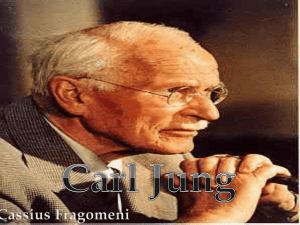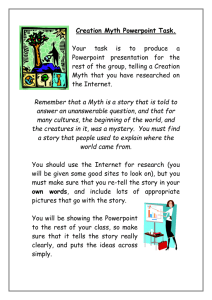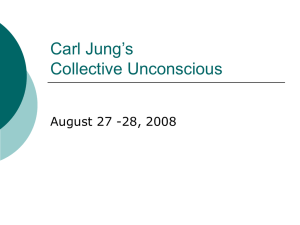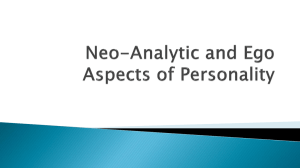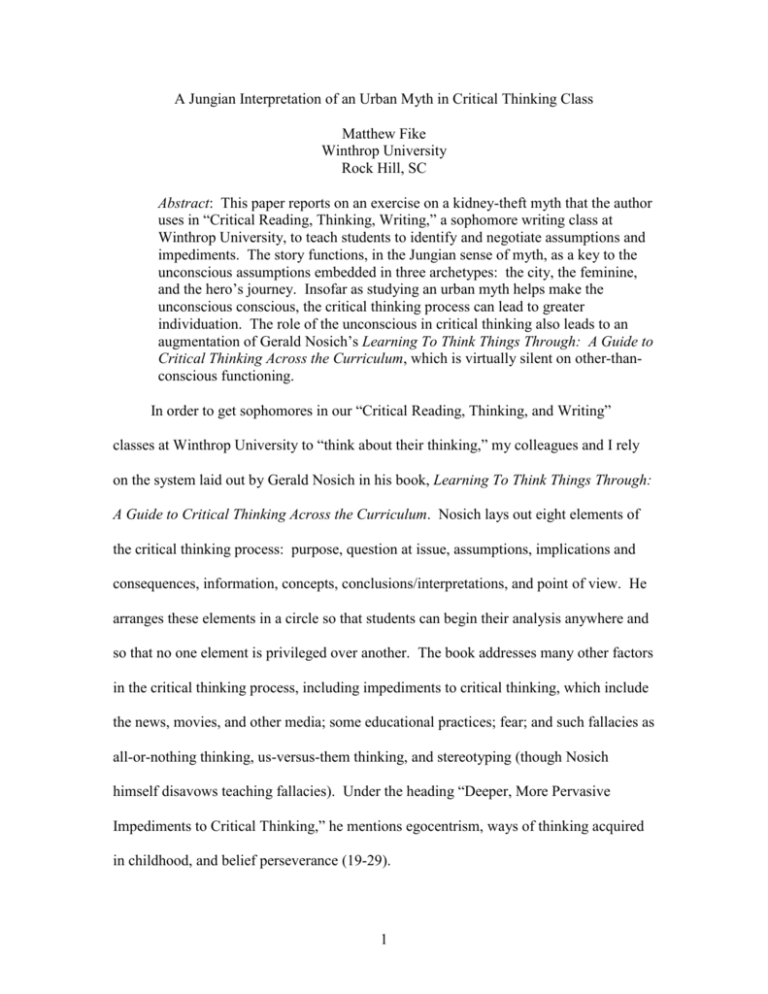
A Jungian Interpretation of an Urban Myth in Critical Thinking Class
Matthew Fike
Winthrop University
Rock Hill, SC
Abstract: This paper reports on an exercise on a kidney-theft myth that the author
uses in “Critical Reading, Thinking, Writing,” a sophomore writing class at
Winthrop University, to teach students to identify and negotiate assumptions and
impediments. The story functions, in the Jungian sense of myth, as a key to the
unconscious assumptions embedded in three archetypes: the city, the feminine,
and the hero’s journey. Insofar as studying an urban myth helps make the
unconscious conscious, the critical thinking process can lead to greater
individuation. The role of the unconscious in critical thinking also leads to an
augmentation of Gerald Nosich’s Learning To Think Things Through: A Guide to
Critical Thinking Across the Curriculum, which is virtually silent on other-thanconscious functioning.
In order to get sophomores in our “Critical Reading, Thinking, and Writing”
classes at Winthrop University to “think about their thinking,” my colleagues and I rely
on the system laid out by Gerald Nosich in his book, Learning To Think Things Through:
A Guide to Critical Thinking Across the Curriculum. Nosich lays out eight elements of
the critical thinking process: purpose, question at issue, assumptions, implications and
consequences, information, concepts, conclusions/interpretations, and point of view. He
arranges these elements in a circle so that students can begin their analysis anywhere and
so that no one element is privileged over another. The book addresses many other factors
in the critical thinking process, including impediments to critical thinking, which include
the news, movies, and other media; some educational practices; fear; and such fallacies as
all-or-nothing thinking, us-versus-them thinking, and stereotyping (though Nosich
himself disavows teaching fallacies). Under the heading “Deeper, More Pervasive
Impediments to Critical Thinking,” he mentions egocentrism, ways of thinking acquired
in childhood, and belief perseverance (19-29).
1
My paper reports on an exercise that I designed to give students practice in
identifying assumptions and the related impediments to critical thinking. These include
not only faulty assumptions and false information leading to incorrect conclusions but
also, and I believe more importantly, the tendency to think in purely binary terms and
unknowingly to project unconscious content onto a text. As I lay out my assignment and
describe what is possible to do with it in a critical thinking class, I hope to augment
Nosish by showing that some impediments are not exclusively conscious constructs;
some of them arise instead from partly or purely unconscious content—in other words,
from the realm of archetypes or what Carl Jung calls the collective unconscious.
The text that I use for this exercise is an urban myth entitled “Reason to not party
anymore” (the vexing split infinitive appears in the original). The heading reads as
follows: “This story came from the ‘Daily Texan’—the University of Texas newspaper.
Apparently it occurred during Fall Premier—a UT tradition that is a celebration of the
end of midterms.” Right away, the English professor in me anticipates a cautionary tale
about the carnivalesque. Here it is in full:
This guy went out last Saturday night to a party. He was having a good
time, had a couple of beers and some girl seemed to like him and invited him
to go to another party. He quickly agreed and decided to go along with her.
She took him to a party in some apartment and they continued to drink, and
even got involved with some other drugs (unknown which).
The next thing he knew, he woke up completely naked in a bathtub filled
with ice. He was still feeling the effects of the drugs, but looked around to see
2
he was alone. He looked down at his chest, which had “CALL 911 OR YOU
WILL DIE” written on it in lipstick.
He saw a phone was on a stand next to the tub, so he picked it up and
dialed. He explained to the EMS operator what the situation was and that he
didn’t know where he was, what he took, or why he was really calling.
She advised him to get out of the tub. He did, and she asked him to look
himself over in the mirror. He did, and appeared normal, so she told him to
check his back. He did, only to find two 9 inch [sic] slits on his lower back.
She told him to get back in the tub immediately, and they sent a rescue team
over.
Apparently, after being examined, he found out more of what had
happened. His kidneys were stolen. They are worth 10,000 dollars each on
the black market. (I was unaware this even existed.) Several guesses are in
order: The second party was a sham, the people involved had to be at least
medical students, and it was not just recreational drugs he was given.
Regardless, he is currently in the hospital on life support, awaiting a spare
kidney. The University of Texas in conjunction with Baylor University
Medical Center is conducting tissue research to match the sophomore student
with a donor.
I wish to warn you about a new crime ring that is targeting business
travelers. This ring is well organized, [is] well funded, has very skilled
personnel, and is currently in most major cities, and recently [has been] very
active in New Orleans. The crime begins when a business traveler goes to a
3
lounge for a drink at the end of the work day. A person in the bar walks up as
they sit alone and offers to buy them a drink. The last thing the traveler
remembers until they wake up in a hotel room bath tub, their body submerged
to their neck in ice, is sipping that drink.
There is a note taped to the wall instructing them not to move and to call
911. A phone is on a small table next to the bathtub for them to call. The
business traveler calls 911 who have become quite familiar with this crime.
The business traveler is instructed by the 911 operator to very slowly and
carefully reach behind them and feel if there is a tube protruding from their
lower back. The business traveler finds the tube and answers, “Yes.” The
911 operator tells them to remain still, having already sent paramedics to help.
The operator knows that both of the business traveler’s kidneys have been
harvested.
This is not a scam or out of a science fiction novel, it is real. It is
documented and confirmable. If you travel or someone close to you travels,
please be careful. Sadly, this is very true. My husband is a Houston
firefighter/EMT and they have received alerts regarding this crime ring. It is
to be taken very seriously. The daughter of a friend of a fellow firefighter had
this happen to her. Skilled doctors are performing these crimes (which, by the
way, have been highly noted in the Las Vegas area)! Additionally, the
military has received alerts regarding this. This story blew me away. I really
want as many people to see this as possible[,] so please bounce this to
whoever you can.
4
The first thing to say about this urban myth is that it is a myth. Here is what The
Daily Texan had to say: “It never happened. Not at the University, not in Austin, not in a
plane, not in a train, not even in a box or with a fox…. The kidney-theft story is an urban
myth. Don’t believe it.” But the story is myth not just in the sense that it is fictitious; it
is also a myth in a psychological sense. Myth, for Jung, functions, as do dreams for
Freud, as a “royal road” to the unconscious. For example, Jung maintains that “myths
never were and never are made consciously[;] they arise from man’s unconscious”; “they
are…manifestations of unconscious impulses, comparable to dreams” (CW 4, par. 463).
He adds that myth “is essentially a product of the unconscious archetype and is therefore
a symbol which requires psychological interpretation” (CW 10, par. 625). Jung even
states that “the whole of mythology could be taken as a sort of projection of the collective
unconscious,” which he calls “the treasure-house of primordial images” (CW 8, par. 325;
7, par. 110).
Here is a longer statement that bears more directly on “Reason to not party
anymore”; mythology, says Jung, is
collective psyche, not individual psyche. In so far as through our
unconscious we have a share in the historical collective psyche, we live
naturally and unconsciously in a world of werewolves, demons, magicians,
etc., for these are things which all previous ages have invested with
tremendous affectivity. Equally we have a share in gods and devils,
saviours and criminals [think kidney thieves]; but it would be absurd to
attribute these potentialities of the unconscious to ourselves personally. It
is therefore absolutely essential to make the sharpest possible demarcation
5
between the personal and the impersonal attributes of the psyche. (CW 7,
par. 151)
So here is what we are saying about Jung on myth. Unlike Freud, Jung distinguishes
between the personal unconscious (the realm of neurosis) and the collective unconscious
(the realm of the archetypes, which are the sources of myth). Myths are thus the things
into which we put what we do not know that we know. Therefore, the study of myth
provides access to the collective unconscious, which is to say a window into the
transpersonal human condition.
But mythical material can also function as an impediment to critical thinking. My
purpose in the remainder of this paper is not to “go around the circle” of elements1 but to
provide a Jungian reading of “Reason to not party anymore” in order to show how the
1
Regarding the kidney-theft story, I first ask my critical thinking students such questions
as the following:
How do Nosich’s elements of critical thinking illuminate the kidney theft
tale? To take a quick example of one element, my students said that key
concepts are supply and demand and the biblical idea that “the wages of
sin is death” (Romans 6:23).
A further question: Does analyzing the tale reveal how and why
reasoning can go wrong? Here I am after the role of emotion in the story
and in the reader, along with the idea that starting with a false assumption
and piling on false information lead to a false conclusion. For example,
“guesses” morph into something “real” and “very true.” And by the end
of the story, it is no longer “medical students” who steal a college
student’s kidneys but “skilled doctors” who steal kidneys from business
travelers. The myth appears to gain force and certainty as it goes along,
like a snowball rolling down a hill. In other words, the story is a slippery
slope.
A third question: What assumptions underlie the kidney theft tale, and
how do they impede critical thinking? For example, the most obvious
assumption is that New Orleans and Las Vegas are centers for vice. A
story that mentions those places in connection with decadent behavior
triggers cultural stereotypes, which is why I assert a close relationship
between assumptions and impediments.
6
story hooks our archetypes in a way that promotes credulity and hinders critical thinking.
There are three main archetypes here: the city, the feminine archetype or anima, and the
hero.
Regarding setting in general and city in particular, there is a clear opposition
between good and evil: the University of Texas at Austin, Baylor University (whose
website calls it “the largest Baptist university in the world”), and the city of Houston—all
good places that are secular/religious or civic/educational—are set in opposition to the
country’s two major sin centers, New Orleans and Las Vegas, with the additional
suggestion that kidney theft “is currently in most major cities.” (I detect a whiff of
deconstruction, though: Houston is a major city, is it not?) Of course, as we all know
well, universities are not all good, nor are major cities all bad. As Shakespeare puts it in
All’s Well That Ends Well, “The web of our life”—and that includes geography, I
presume—“is of a mingled yarn, good and ill together” (IV.iii). But the story hammers
the reader with binary oppositions: the world is not good and bad but good or bad. In
the “good” category, along with Houston and the two schools, are the 911 operator, the
EMTs, the firefighter, the military, the friend’s daughter, and the narrator. In the “bad”
category, besides New Orleans, Las Vegas, and “most major cities,” there are fast women,
medical students, doctors, alcohol, drugs, and the black market. In other words, the
story’s use of geographical setting relates to a larger pattern of impediments to critical
thinking that Nosich identifies in his book: namely, black-and-white thinking (22) or
what those of us who believe in teaching students about fallacies call false dichotomy. In
short, the story hooks us by activating the archetypes of good and evil that underlie our
conscious understanding of place.
7
Before passing on to the second archetype, I want to say a few words about the
other element of setting, which is time. The story is dated November 20, 1997, which
places it two years after the Lewinsky internship and three years out from the publication
of Christopher Moore’s comic novel, Island of the Sequined Love Nun, whose pilot hero,
Tucker Case, after losing his job as a result of a crash that impales his masculine organ on
a Learjet’s joystick, gets unknowingly involved in transporting—you guessed it—stolen
kidneys. Directly following these historical and fictional precursors, “Reason to not party
anymore” appeared at the right moment in American history to be believable by
appealing to our collective fatigue and unease as regards sexual adventuring.
The story also features various feminine or anima types. “This guy,” as the story
calls our hapless sophomore, meets “some girl” at a party; “CALL 911 OR YOU WILL
DIE” is written on his chest in lipstick as though he is simultaneously betrayed and saved
by the feminine; the 911 operator is a woman; “the daughter of a friend” falls victim to
kidney theft; and the narrator is a married woman from Houston. Many of these figures
illustrate Jung’s division of the feminine archetype into subcategories (CW 16, par. 361).
First, there is Helen, who represents anima that bewitches and misguides like the “girl” at
the party. Second, Sophia provides wisdom and guidance like the 911 operator or the
narrator herself. A Sophia-like woman is a Sibyl figure, whom Jung calls “a feminine
psychopomp,” one who guides the souls of the dead (CW 14, par. 287), or whom James
Hillman calls “a girl guide” (133). The narrator also illustrates a third type, Eve, or
wifely anima, which suggests, by extension, proper male-female partnership (the narrator
is married to a Houston firefighter and is the type of female whom our sophomore should
ultimately wed; or, in Buffy the Vampire Slayer terms, the sophomore is Xander, the
8
narrator is Willow, and the girl at the party is Faith). A fourth and final type, Mary, the
mother of Jesus, provides maternal nurturing but can also smother. Think of the way that
the sophomore begins at the University of Texas (an alma mater, a fostering or perhaps
smothering mother), strays into decadent behavior with disastrous results, and ends up on
life support either at UT or at another fostering/smothering mother, Baylor University,
awaiting a transplant and coming to Jesus the way people do after decadence has wrecked
their lives. (I made up that last part about coming to Jesus, but it is not far-fetched given
Baylor’s conservative religious ethos.) The story also introduces a fifth type of anima,
one not mentioned in Jung’s Collected Works, which I will call Desdemona, the innocent
victim, illustrated by “the daughter of a friend” whose kidneys are previously stolen.
The point here is that the story “Reason to not party anymore” hooks the reader and
impedes critical thinking by confronting him—and I mean especially the male reader—
with aspects of the internal feminine. The story is thus fertile ground for projection: a
male reader is bound to locate in the story some echo of his own feminine element,
participate vicariously, and find the story credible as a result. Projection, or seeing in the
other a quality of the self, is the opposite of individuation, Jung’s term for integrating
parts of the psyche by making the unconscious conscious. So the kidney story is really a
fable about the harm that can come to a person when he—or she, as the case may also
be—projects rather than properly integrates psychic content. We even have a projection
within a projection: readers project their feminine aspect onto a tale of a young man who
does the very same with the females whom he encounters during his misadventures.
The presence of psychic integration will become clearer if we examine the third
and final archetype that the story activates: that of the hero. The hero’s journey, as in
9
Joseph Campbell’s Hero with a Thousand Faces, has three parts: departure from an
original setting; an initiation such as a descent into hell or an encounter with danger,
temptation, violence, or crime; and a return to the original setting once the hero, now a
better and stronger person, has properly negotiated the second stage. This archetypal
pattern is built into “Reason to not party anymore.” Like Odysseus, our sophomore sets
out from the University of Texas and encounters a Circe figure—a beautiful, enticing
woman with drugs who, by embodying what a man both fears and desires, activates what
Freud in Totem and Taboo calls “the ambivalence of emotions.” A further Odyssean
analogy is that the story conflates the Sirens, bird-women who represent the dangerous
feminine that every man desires but no man can withstand, with the lotus eaters who
tempt sailors to abandon responsibility in favor of chemically induced oblivion.
The sophomore’s encounter in stage two, then, resembles the epic hero’s but with
vastly different results. The young man is no Odysseus; instead he is more like the
prodigal son (Luke 16), overcome by his initiation and forced to return not to his
profusely generous father but to a conservative fostering mother (possibly Baylor). He is
a failed initiate on whom we as readers, especially male readers, project our fears not just
of the feminine but also of the absence of reason (note that the female 911 dispatcher, the
Sophia or Athena figure, intercedes only after he has been mutilated). Fear, in fact, is
ever-present in the story because it portrays a purportedly binary universe where it is
often difficult to discern good from evil, Dr. Schweitzer from Dr. Lecter, and where the
penalty for misperception of a siren figure is evisceration (an apt analogy because sirens
can tear men to pieces with their talons).
10
“Reason to not party anymore” thus depicts not historical fact but psychological
truth: it is a myth that enacts an encounter with the archetypes of the collective
unconscious. Whereas it is misguided to believe such a myth, we may learn from it in
ways that promote individuation by overcoming the impediments that may initially trick
us into credulity. In other words, if we realize that myth activates archetypes, then to
think critically about an urban myth, as I have my students do in class with the kidneytheft story and in groups with different urban myths of their own choosing, is to become a
more integrated personality: critical thinking promotes personal growth; thinking
critically and becoming a whole person are mutually supportive activities. My point to
Professor Nosich, then, is that not all impediments are conscious constructions. He does
admit that “decisions can be made below the level of our awareness” (28), but he does
not explore the impact of thinking that is other-than-conscious on the elements in general
or impediments in particular. Surely, some impediments have their roots in the neuroses
and complexes of the personal unconscious or, as I have argued in this paper, in the
collective unconscious whose archetypes myth figures forth. Integrating unconscious
forces into a discussion of impediments provides a way of tracking assumptions back to
their source and can helpfully augment students’ critical thinking. This is important, for,
as Jung writes, myths “seek to translate natural secrets into the language of consciousness
and to declare the truth that is the common property of mankind” (CW 13, par. 395).
11
Works Cited
“About Baylor.” 26 Sept. 2005. 19 Dec. 2005 <http://www.baylor.edu/about>.
Campbell, Joseph. The Hero with a Thousand Faces. Princeton: Princeton UP,
1949.
Freud, Sigmund. Totem and Taboo: Some Points of Agreement Between the
Mental Lives of Savages and Neurotics. New York: Norton, 1950
Harper Study Bible. Revised Standard Version. Grand Rapids, MI: Zondervan, 1965.
Hillman, James. Anima: An Anatomy of a Personified Notion. Dallas: Spring,
1985.
Homer. Odyssey. Ed. Richmond Lattimore. New York: Harper, 1967.
Jung, C.G. Collected Works of C.G. Jung. Trans. R.D.F. Hull. Ed. Sir Herbert
Read et al. Bollingen Series 10. Princeton: Princeton UP, 1969. 20 vols.
Nosich, Gerald. Learning To Think Things Through: A Guide to Critical Thinking
Across the Curriculum. 2nd ed. Upper Saddle River, NJ: Pearson/Prentice
Hall, 2005.
Moore, Christopher. Island of the Sequined Love Nun. New York: Perennial, 2004.
“Reason to not party anymore.” Urban Legends and Folklore. 20 Nov. 1997.
31 Mar. 2005 <http://urbanlegends.miningco.com/library/blkidney.htm>.
Shakespeare, William. All’s Well That Ends Well. The Complete Works of
Shakespeare. Ed. David Bevington. 4th ed. New York: HarperCollins,
1992. 362-403.
12



